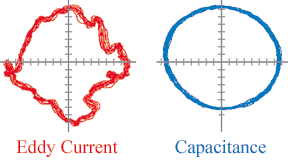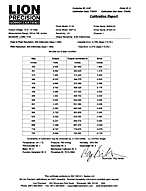The only measurement that counts measures runout while the spindle is turning at operating speed. Static dial indicator measurements have little correlation with spindle performance while in operation.
Lion Precision introduced the term Dynamic Runout when they released the first Targa system in 1994. Until then, no one had measured high-speed drill spindles in a production environment. It caused quite a stir in the industry and the term Dynamic Runout is now heard in drill rooms everywhere.
Cheap measurement systems can’t be trusted.
 Inexpensive runout measurement systems currently on the market do not produce accurate results. They use eddy-current technology in the runout sensor. Eddy current technology does not work well with rotating, ferromagnetic targets. The Targa III uses capacitive sensors which are not affected by a rotating target. This chart shows a runout measurement of the same spindle using eddy current and capacitive sensors. The eddy current sensor output is distorted. It is impossible for this to produce a meaningful measurement of runout. The capacitive sensor output is clean and accurate.
Inexpensive runout measurement systems currently on the market do not produce accurate results. They use eddy-current technology in the runout sensor. Eddy current technology does not work well with rotating, ferromagnetic targets. The Targa III uses capacitive sensors which are not affected by a rotating target. This chart shows a runout measurement of the same spindle using eddy current and capacitive sensors. The eddy current sensor output is distorted. It is impossible for this to produce a meaningful measurement of runout. The capacitive sensor output is clean and accurate.
Built-in measurement systems are limited.
Some drilling machines have built-in laser measurement systems. While these systems do measure Dynamic Runout, they are primarily intended to check the tool diameter and are limited in accuracy; they cannot be calibrated; and they only take a measurement at the set drilling speed. With today’s shrinking hole sizes and spacing, greater accuracy is required.
Only the Targa III is ISO 9000 compliant.

When your friendly ISO 9000 auditors see a measurement device on your drilling machine they will ask you, “How do you know it’s accurate?” Only the Targa III comes with an ISO 9000 compliant, NIST traceable calibration certificate and a calibration certification sticker on each system.
